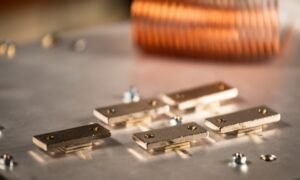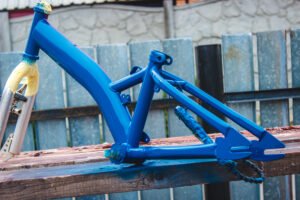Metal Surface Treatment
Grinding Services
Grinding is a critical process in the manufacturing and finishing of metal parts, known for its ability to achieve high precision and surface finish. At CNV Engineering, our grinding services are utilized to improve the surface quality of components, making them smoother and more uniform. This process is particularly valuable in applications where tight tolerances and smooth surfaces are crucial, such as in the automotive, aerospace, and toolmaking industries.
Grinding uses an abrasive wheel as the cutting tool to remove material from the workpiece surface. The accuracy of this process makes it ideal for finishing operations after casting, forging, or machining, offering an excellent way to achieve fine tolerances and accurate dimensions. It’s also commonly used for hard materials that are difficult to machine with other methods.
Key Advantages of Grinding:
Precision Surface Finish: Achieves a very smooth surface finish, essential for many high-precision parts.
Accuracy and Consistency: Grinding is capable of achieving high dimensional accuracy and consistency in parts.
Versatility: Suitable for a range of materials including metals and hard materials.
Surface Treatment Services
Surface Treatment plays a pivotal role in enhancing the performance and longevity of metal components. At CNV Engineering, we offer comprehensive surface treatment services that not only improve the aesthetic appeal of products but also provide essential protection against environmental factors.
Key Benefits of Surface Treatment:
Enhanced Durability: Surface treatment processes, such as coating and smoothing, protect metal from corrosion, wear, and tear.
Improved Aesthetics: Achieves a more polished and refined look, which is important for visible components.
Heat Treatment Services:
Heat treatment is a controlled process used to alter the physical and sometimes chemical properties of a material. Our heat treatment services are essential for modifying the mechanical properties of metals, ensuring they meet the specific performance requirements of various applications.
Key Benefits of Heat Treatment:
Mechanical Property Enhancement: Heat treatment improves strength, ductility, and toughness of metals.
Stress Relief: It relieves internal stresses in materials, reducing the risk of failure during use.
Microstructure Refinement: Refines the microstructure of metals, enhancing their performance characteristics.
Both surface and heat treatment are integral to the manufacturing process, providing our clients with components that are not only high in quality but also tailored to withstand the demands of their specific applications.
To understand more about the processes, check the toggle headings below.
Gallery






Powder Coating ?
Powder Coating is a versatile and durable finishing method used at CNV Engineering for metal parts. This process involves the electrostatic application of a dry powder, followed by a heat treatment that fuses the powder into a smooth, uniform coating. This technique not only provides an expansive range of color choices but also significantly enhances the part’s resistance to wear and corrosion.
The advantages of powder coating include its robust protective layer, aesthetic flexibility, and environmental friendliness, as it releases fewer volatile organic compounds (VOCs) compared to traditional paints. Ideal for various applications such as automotive components and architectural hardware, powder coating ensures a high-quality finish that combines durability with visual appeal.
Wet Painting
Traditional wet paint application remains a fundamental surface treatment method at CNV Engineering, particularly suited for metals that cannot be subjected to the high temperatures required for powder coating. This method involves applying liquid paint to metal parts, offering a solution where heat-sensitive materials need finishing.
One of the key advantages of traditional painting is its extensive color palette, providing a broader range of hues and finishes compared to powder coating. Additionally, it allows for the application of thicker coatings, which can be advantageous in certain environments where powder coating might not offer the same level of durability. In some specific applications, traditional wet paint can provide a more long-lasting finish, making it an essential option in our surface treatment repertoire.
Ideal for a variety of applications, traditional wet painting is particularly valuable in projects requiring specific color matching or where materials are sensitive to heat.
Deburring
At CNV Engineering, our deburring process is essential for refining the edges of metal parts post-cutting. While laser cutting often yields clean edges, other methods might leave rougher surfaces. To address this, we use deburring machines with conveyor belts and brushes that uniformly smooth larger parts. For smaller components, we employ vibro machines that polish the parts using a mixture of abrasive media like sand, stones, or small balls. These methods ensure every part, regardless of size, achieves a high-quality finish, adhering to our commitment to precision and excellence.
Electroplating
Electroplating at CNV Engineering is a sophisticated process that enhances the properties of metal parts through electrolysis. This technique involves depositing a thin layer of metal atoms onto a workpiece, thereby improving its physical, mechanical, and chemical characteristics.
The process of electroplating not only augments the corrosion and wear resistance of the base material but also often aims to enhance the product’s aesthetic appeal. A common example is nickel electroplating, which provides a polished and refined finish to the surface. By applying this additional metal layer, we ensure that the components not only perform better but also meet higher standards of visual quality.
Electropolishing
This electrochemical procedure smooths and streamlines the metal’s surface by removing a thin layer of material. It functions oppositely to electroplating; instead of adding, it meticulously removes surface irregularities.
This process enhances the corrosion resistance and aesthetic appeal of components. Electropolishing is especially beneficial in applications where a clean, smooth, and shiny surface is desired. It also helps in reducing surface roughness and removing microscopic burrs, which can be crucial for parts used in the food processing, medical, and pharmaceutical industries.
Buffing Finishing
Buffing is a critical finishing process used to enhance the surface finish of metal parts. This technique involves the use of a soft abrasive buffing wheel to smooth out the surface, resulting in a high-gloss, mirror-like finish. The process effectively removes surface imperfections, such as scratches and minor nicks, enhancing both the appearance and tactile quality of the metal.
Ideal for a range of applications, buffing is particularly valuable in industries where both aesthetic and functional surface quality are paramount. It’s widely used for automotive parts, decorative hardware, and components in consumer products. The resulting polished surface not only improves the visual appeal but also contributes to better corrosion resistance and ease of cleaning, making it a preferred choice for high-quality finishing.
Annealing
Annealing is a crucial heat treatment process employed to modify the physical properties of various metals, including steels, cast iron, aluminum, and numerous alloys. This process primarily aims to reduce hardness while enhancing ductility and toughness, making materials more workable and less prone to cracking.
The annealing procedure involves heating the workpiece above its recrystallization temperature, followed by controlled cooling. Typically, annealing is performed after mechanical operations like bending, forming, rolling, grinding, or drawing, which can leave the metal hard and brittle. By undergoing annealing, these metals are restored to a more malleable state, facilitating further processing and reducing the risk of damage.
Beyond improving workability, annealing plays a significant role in stress relief. It is often the final heat treatment operation, crucial for prolonging part service life and enhancing operational capabilities. Additionally, annealing can soften weld solidifications and is known to improve electrical conductivity in certain materials.
Tempering
Tempering is a crucial heat treatment technique designed to enhance the mechanical properties of metals, particularly used for components that have undergone hardening. This process involves heating the material to a temperature below its critical point, then maintaining it at this temperature for a specific duration before allowing it to cool in still air.
The primary objective of tempering is to mitigate the brittleness typically introduced during the hardening process. By reheating hardened metals to lower temperatures, tempering restores some ductility while maintaining a significant degree of hardness. This careful recalibration allows for an optimal balance between hardness and flexibility in the metal.
Tempered metals are particularly valuable in applications where a certain degree of elasticity is required alongside hardness. While the process can theoretically be applied to a broad range of metals, it is most commonly associated with carbon steel. This is because carbon steel uniquely responds to tempering, adjusting its properties in a way that is particularly beneficial for various applications.
The tempering process plays a significant role in manufacturing industries, especially where the durability and performance of steel components are critical. It ensures that parts can withstand operational stresses while maintaining their structural integrity.
Case Hardening
Case hardening is a specialized heat treatment process that hardens the surface of a metal while keeping its core relatively soft. This method ingeniously combines the best attributes of both hard and soft metals into a single component, making it particularly valuable in various manufacturing applications.
A soft material inherently exhibits superior impact resistance, greater toughness, ductility, and strength. However, it often lacks sufficient wear resistance, which is crucial for parts that are subject to abrasion or friction. Case hardening addresses this by selectively hardening the outer surface of the metal. This results in enhanced wear resistance on the surface while preserving the core’s impact resistance and ductility.
The process varies depending on the carbon content of the metal. For metals with sufficient carbon, simply heating and quenching the part may be adequate. However, in cases where the carbon content is low or extreme surface hardness is required, additional elements like carbon (in carburizing) or nitrogen (in nitriding) are introduced to the material’s surface. These treatments enrich the surface layer, significantly increasing its hardness and wear resistance.
Case hardening is particularly effective for components that need to withstand high levels of mechanical stress without succumbing to wear, making it a preferred choice in industries where both durability and performance are key.
Contact
+91- 90035 99554
sales@cnve.in
Schedule a Call
